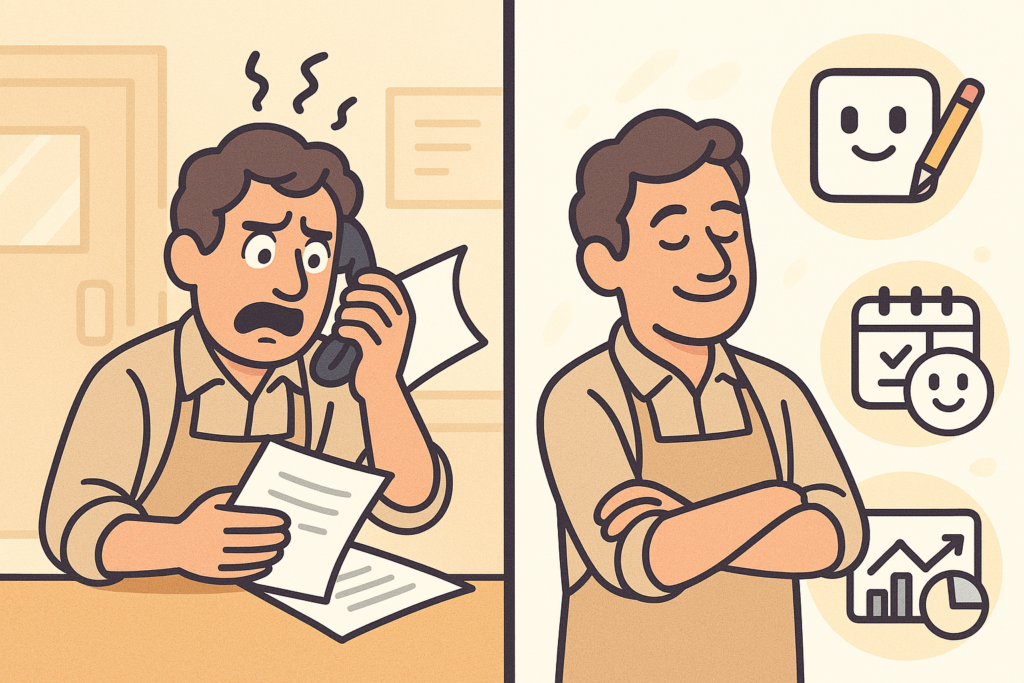Need Images? An Introduction to AI Image Generators for Your Business
You know high-quality visuals are crucial for capturing attention online – on your website, blog posts, social media, and marketing materials. But hiring a graphic designer for every image or spending hours searching stock photo sites isn’t always feasible. Enter AI image generators.
These fascinating tools use AI to create completely unique images from simple text descriptions (prompts). Tools like Midjourney, DALL-E 3 (often accessed via ChatGPT Plus or Microsoft Copilot), Stable Diffusion (and tools built on it like Leonardo.ai or NightCafe), and Canva’s built-in generator are changing how we create visuals.
How Do They Work?
You provide a text prompt describing the image you want (e.g., “A friendly robot helping a small business owner organize paperwork in a bright, modern office, cartoon style”). The AI analyzes your prompt and generates one or more images based on its vast training data of images and text associations.
Potential Uses for Your Small Business:
- Blog Post Illustrations: Create unique featured images or illustrations that perfectly match your article’s topic.
- Social Media Graphics: Generate eye-catching visuals for Instagram, Facebook, LinkedIn, etc.
- Marketing Concepts: Quickly visualize ideas for ad campaigns or promotional materials.
- Website Banners & Icons: Create custom graphics that fit your brand identity.
- Presentation Slides: Add unique visuals to make your presentations more engaging.
- Brainstorming: Visualize product ideas or concepts.
Key Players & Access (Early 2025):
- Midjourney: Known for high-quality, artistic results. Typically accessed via Discord (a chat app) and requires a paid subscription. Can have a steeper learning curve.
- DALL-E 3 (OpenAI): Integrated into ChatGPT Plus (paid) and Microsoft Copilot (often free). Known for following prompts accurately and generating text within images. Generally user-friendly.
- Stable Diffusion: An open-source model. Many tools use it, offering various interfaces and pricing (some free options). Quality and ease of use vary depending on the specific tool. Examples: Leonardo.ai, NightCafe Creator.
- Canva Magic Media: Integrated directly into the popular Canva design platform (has free and paid tiers). Very accessible for existing Canva users.
Things to Keep in Mind:
- Prompting is Key: The quality and relevance of the generated image depend heavily on how well you write your text prompt. Be descriptive – specify the subject, action, style (e.g., photorealistic, cartoon, watercolor), lighting, and mood. Experimentation is required!
- Style & Consistency: Achieving a consistent visual style across multiple images can be challenging.
- “Weirdness” Factor: AI can sometimes produce strange results, especially with hands, complex scenes, or specific details. You might need to generate multiple options or refine your prompt.
- Usage Rights: Pay close attention to the terms of service for each tool regarding commercial use of the generated images. Policies vary and are evolving. Generally, paid tiers offer clearer commercial rights.
- Ethical Considerations: Be mindful of generating misleading images or replicating copyrighted styles too closely.
Getting Started:
- Try an Accessible Tool: Start with something user-friendly like Canva’s generator or Microsoft Copilot’s DALL-E 3 integration.
- Experiment with Simple Prompts: Describe basic scenes or objects.
- Refine Your Prompts: Add details about style, color, and composition. See how the results change.
AI image generators offer an exciting, cost-effective way to create unique visuals for your business. While they require some learning and experimentation, they can be a powerful addition to your creative toolkit.

